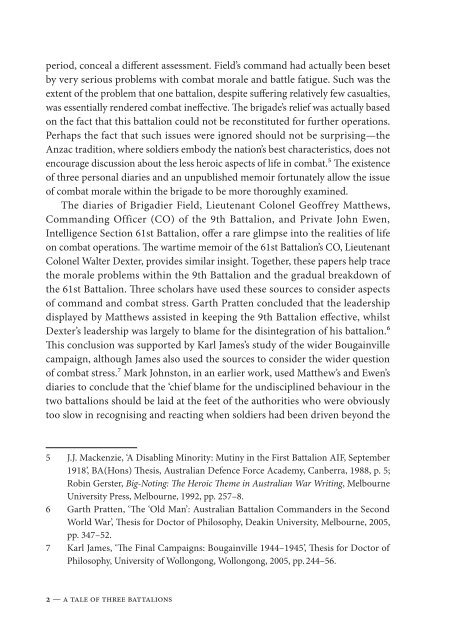View the pdf - Australian Army
View the pdf - Australian Army
View the pdf - Australian Army
You also want an ePaper? Increase the reach of your titles
YUMPU automatically turns print PDFs into web optimized ePapers that Google loves.
period, conceal a different assessment. Field’s command had actually been besetby very serious problems with combat morale and battle fatigue. Such was <strong>the</strong>extent of <strong>the</strong> problem that one battalion, despite suffering relatively few casualties,was essentially rendered combat ineffective. The brigade’s relief was actually basedon <strong>the</strong> fact that this battalion could not be reconstituted for fur<strong>the</strong>r operations.Perhaps <strong>the</strong> fact that such issues were ignored should not be surprising—<strong>the</strong>Anzac tradition, where soldiers embody <strong>the</strong> nation’s best characteristics, does notencourage discussion about <strong>the</strong> less heroic aspects of life in combat.5 The existenceof three personal diaries and an unpublished memoir fortunately allow <strong>the</strong> issueof combat morale within <strong>the</strong> brigade to be more thoroughly examined.The diaries of Brigadier Field, Lieutenant Colonel Geoffrey Mat<strong>the</strong>ws,Commanding Officer (CO) of <strong>the</strong> 9th Battalion, and Private John Ewen,Intelligence Section 61st Battalion, offer a rare glimpse into <strong>the</strong> realities of lifeon combat operations. The wartime memoir of <strong>the</strong> 61st Battalion’s CO, LieutenantColonel Walter Dexter, provides similar insight. Toge<strong>the</strong>r, <strong>the</strong>se papers help trace<strong>the</strong> morale problems within <strong>the</strong> 9th Battalion and <strong>the</strong> gradual breakdown of<strong>the</strong> 61st Battalion. Three scholars have used <strong>the</strong>se sources to consider aspectsof command and combat stress. Garth Pratten concluded that <strong>the</strong> leadershipdisplayed by Mat<strong>the</strong>ws assisted in keeping <strong>the</strong> 9th Battalion effective, whilstDexter’s leadership was largely to blame for <strong>the</strong> disintegration of his battalion.6This conclusion was supported by Karl James’s study of <strong>the</strong> wider Bougainvillecampaign, although James also used <strong>the</strong> sources to consider <strong>the</strong> wider questionof combat stress.7 Mark Johnston, in an earlier work, used Mat<strong>the</strong>w’s and Ewen’sdiaries to conclude that <strong>the</strong> ‘chief blame for <strong>the</strong> undisciplined behaviour in <strong>the</strong>two battalions should be laid at <strong>the</strong> feet of <strong>the</strong> authorities who were obviouslytoo slow in recognising and reacting when soldiers had been driven beyond <strong>the</strong>5 J.J. Mackenzie, ‘A Disabling Minority: Mutiny in <strong>the</strong> First Battalion AIF, September1918’, BA(Hons) Thesis, <strong>Australian</strong> Defence Force Academy, Canberra, 1988, p. 5;Robin Gerster, Big-Noting: The Heroic Theme in <strong>Australian</strong> War Writing, MelbourneUniversity Press, Melbourne, 1992, pp. 257–8.6 Garth Pratten, ‘The ‘Old Man’: <strong>Australian</strong> Battalion Commanders in <strong>the</strong> SecondWorld War’, Thesis for Doctor of Philosophy, Deakin University, Melbourne, 2005,pp. 347–52.7 Karl James, ‘The Final Campaigns: Bougainville 1944–1945’, Thesis for Doctor ofPhilosophy, University of Wollongong, Wollongong, 2005, pp. 244–56.2 — A tale of three battalions
















